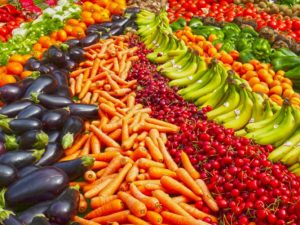I know people who blame the old food pyramid for our obesity epidemic. So, the evolution of the food pyramid has been a welcome progression.
Old Food Pyramid
We were first introduced to the food pyramid in 1992. It seemed simple enough at the time, but a lot of us misunderstood the serving sizes and ranges for the different food groups.
For example, the old pyramid said we should have 6 to 11 servings in the Bread Group, which meant people thought they could eat as much as 11 servings and still maintain a healthy diet.
But here’s what we didn’t account for. The amount of servings we eat should be determined by our calorie requirements and activity levels. So, let’s say you’re pretty sedentary and need around 1,600 calories a day. That means you should only consume 6 servings from the grain group, while more active individuals could enjoy up to 11 servings.
Another problem with the old pyramid is that we didn’t really get servings in those days. A serving isn’t what you eat in one meal. So, if you ate a sandwich with 2 slices of bread, that’s 2 servings from the bread group.
What’s more, the old food pyramid didn’t teach us a whole lot about whole grains, leading us to eat the wrong grains, like refined white bread.
So, diets were based on starches and carbs like pasta and bread. Few people moved upwards in the pyramid to include the recommended servings of fruits and veg.
How the Food Pyramid has changed
In 2005 we were introduced to a new food pyramid. It really wasn’t that much easier to figure out. Each food group was represented by colors, and you needed further explanations to figure out servings.
One main difference, though, which still stands in 2019, is that we don’t really talk about servings. Rather, we talk about recommended daily amounts in ounces, cups, and even fists!
Another big change was that the food pyramid became interactive so you could personalize it based on your activity level and age. This is really important since how much you consume from each food group depends a lot on your daily calorie requirements, which can range anywhere from 1,000 calories a day for a toddler to 3,200 calories a day for an extremely active adult.
The new Food Pyramid
Using the new food pyramid was pretty simple. You entered your age, gender, activity level, and created a customized plan. This presented you with an estimated calorie requirement along with recommended amounts you should eat from each of the food groups.
You could then learn more about the different groups, print out your personalized pyramid and print a worksheet to help you keep track of everything.
The emphasis of exercise was also a welcomed part of the newer food pyramid. This is when we started to realize just how important it is to be physically active for at least 30 minutes a day.
Bye Bye Pyramid, Hello MyPlate
The newer food pyramid was simple enough, but many people still misunderstood the ranges in servings for the food groups, or just had no idea what a serving ought to be. That led to overeating and oversized portions.
The food pyramid was finally put to rest in 2011 and we were introduced to MyPlate, a much easier to follow place setting that helps us visualize a healthy meal complete with the five food groups:- Dairy
- Protein
- Grains
- Fruit
- Vegetables
Do You Get Your Portions Right?
So, while white carbs are out and plant-based everything is in, are you trying to get your portions right? Do you still use the old food pyramid concept or are you more of a MyPlate kind of person?
Check out my latest health tips at marksalinas.com
Image: Pexels

No user commented in " Food Pyramid in 2019 "
Follow-up comment rss or Leave a Trackback